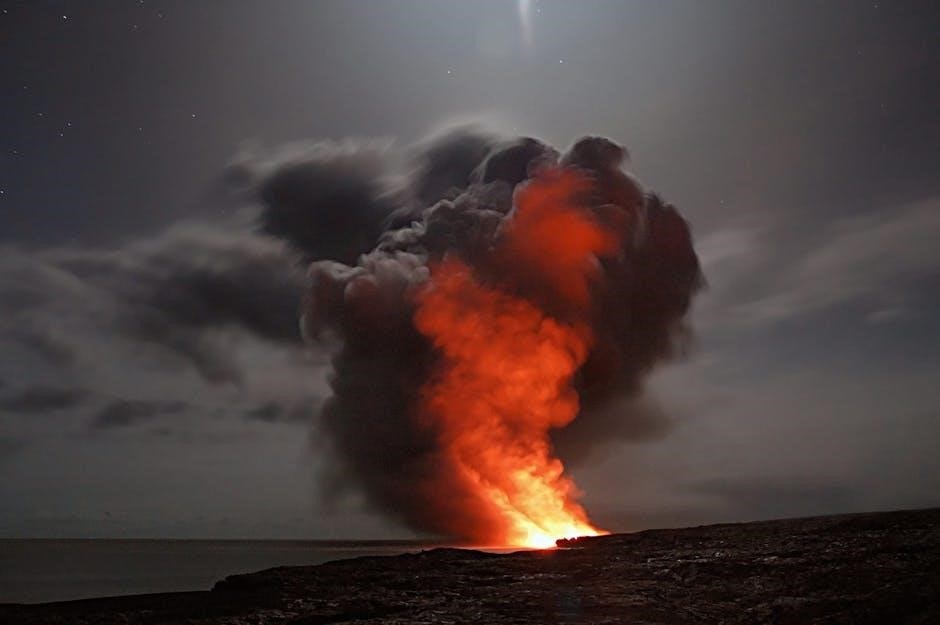Heat and Mass Transfer is a fundamental engineering discipline studying energy and substance transport. It is essential for designing systems like engines and refrigerators, ensuring efficiency and safety. Key topics include conduction, convection, and radiation, as well as mass diffusion. The Fundamentals of Heat and Mass Transfer textbook by Frank P; Incropera is a leading resource, offering comprehensive insights for students and professionals. Understanding these principles is vital for solving real-world engineering challenges and optimizing thermal systems.
Overview of Heat and Mass Transfer Fundamentals
Heat and mass transfer are fundamental processes that govern the transport of energy and substances in various systems. Heat transfer involves the movement of thermal energy due to temperature differences, occurring through conduction, convection, and radiation. Mass transfer refers to the movement of substances, often driven by concentration gradients, and includes diffusion and mass flux. These principles are interconnected, as heat transfer can influence mass transfer and vice versa. Understanding these phenomena is crucial for designing efficient systems in engineering, such as heat exchangers, refrigeration systems, and chemical reactors. The Fundamentals of Heat and Mass Transfer textbook provides a systematic approach to these topics, emphasizing practical applications and theoretical foundations.
Importance of Heat and Mass Transfer in Engineering
Heat and mass transfer are cornerstone disciplines in engineering, essential for solving problems in energy systems, thermal management, and chemical processes. These principles underpin the design of systems like engines, HVAC systems, and heat exchangers, ensuring efficient energy use and system reliability. Engineers rely on heat and mass transfer to optimize performance, safety, and cost-effectiveness in industrial applications. The ability to analyze and predict heat and mass flow is critical for advancing technologies, addressing environmental challenges, and improving process efficiency. As industries evolve, mastering these fundamentals remains vital for innovation and sustainable engineering solutions.

Types of Heat Transfer
Heat transfer occurs through conduction, convection, and radiation. Conduction involves direct contact, while convection relies on fluid motion. Radiation transfers energy via electromagnetic waves, regardless of medium.
Conduction
Conduction is the transfer of heat through direct contact between particles in a material. It occurs when atoms or molecules vibrate, passing energy to adjacent particles. This process relies on temperature differences and material properties like conductivity. In solids, conduction is most efficient, while in fluids and gases, it is less significant. Fourier’s Law of Conduction mathematically describes this phenomenon, linking heat flux to temperature gradients. Conduction is fundamental in engineering, influencing designs from cookware to insulation. Understanding conduction is crucial for optimizing thermal systems and ensuring energy efficiency in various applications, as detailed in resources like the Fundamentals of Heat and Mass Transfer textbook.

Convection
Convection involves heat transfer through the movement of fluids. It occurs when a heated fluid rises, creating circulation as cooler fluid replaces it. This process relies on density changes and buoyancy forces. There are two types: natural convection, driven by gravity, and forced convection, which uses external mechanisms like fans or pumps. Convection is crucial in engineering, particularly in cooling systems and heat exchangers. Newton’s Law of Cooling describes convection heat transfer, linking the heat flux to the temperature difference between a surface and the surrounding fluid. Understanding convection is essential for designing efficient thermal systems, as detailed in resources like the Fundamentals of Heat and Mass Transfer textbook.
Radiation
Radiation is the transfer of heat through electromagnetic waves, occurring in solids, liquids, and gases. Unlike conduction and convection, it does not require a medium, making it significant in vacuum environments. The Stefan-Boltzmann Law governs radiant heat transfer, with the heat flux proportional to the fourth power of the absolute temperature. Emissivity, a material property, influences how efficiently surfaces emit or absorb radiation. Radiation plays a crucial role in industrial heating systems, thermal insulation, and space exploration. Understanding radiation is vital for designing efficient thermal systems, as detailed in textbooks like the Fundamentals of Heat and Mass Transfer, which provides comprehensive insights into its principles and applications.
Mass Transfer Fundamentals
Mass Transfer involves the transport of substances due to concentration gradients. It includes diffusion, where particles move from high to low concentration, and mass flux, the rate of transfer. Key principles are detailed in the Fundamentals of Heat and Mass Transfer textbook, emphasizing practical applications in engineering.
Diffusion and Mass Flux
Diffusion is the spontaneous transport of particles from regions of higher to lower concentration, driven by kinetic energy. It is a fundamental mechanism in mass transfer. Mass flux, measured in kg/m²s, quantifies the rate of mass transfer across a boundary. Fick’s laws govern diffusion, with the first relating flux to concentration gradients and the second describing transient diffusion. These principles are crucial in engineering applications, such as chemical reactors and separation processes, as detailed in resources like the Fundamentals of Heat and Mass Transfer textbook. Understanding diffusion and mass flux is essential for designing efficient systems.

Mass Transfer Coefficients
Mass transfer coefficients quantify the rate of mass transfer between phases, such as gas and liquid. They depend on flow conditions, geometry, and physical properties. The mass transfer coefficient (k) is used in equations like the film theory model. Resources like the Fundamentals of Heat and Mass Transfer provide methods to calculate these coefficients, essential for designing chemical reactors, distillation columns, and absorption systems. Accurate determination of mass transfer coefficients ensures efficient and scalable engineering solutions, as explored in modern research and practical applications.
Applications of Heat and Mass Transfer
Heat and mass transfer are crucial in various industries, including refrigeration, air conditioning, chemical processing, and power generation. They optimize energy systems, enhance safety, and improve efficiency in industrial processes and environmental engineering.

Industrial Processes
Heat and mass transfer play a pivotal role in various industrial processes, ensuring efficiency and safety. In power generation, they optimize heat exchanger performance, crucial for energy conversion. Chemical plants rely on these principles for reactor design and separation processes. HVAC systems utilize heat transfer to regulate temperatures, enhancing comfort and productivity. Additionally, mass transfer is essential in drying technologies, preserving food and materials. These applications highlight the importance of understanding fundamental heat and mass transfer in advancing industrial technologies and maintaining operational excellence across sectors.
Environmental Engineering
Heat and mass transfer are crucial in environmental engineering for addressing pollution and sustainability challenges. Thermal pollution control relies on heat transfer principles to manage discharged water temperatures. Mass transfer is essential for air purification systems, removing pollutants through absorption or adsorption. Waste management technologies, such as incineration and recycling, depend on heat transfer to optimize processes. Renewable energy systems, like solar panels, utilize heat transfer for energy efficiency. These principles also aid in designing green technologies, such as biofilters, to mitigate environmental impacts. Understanding these fundamentals enables engineers to develop solutions that protect ecosystems and promote sustainable development while addressing climate change and resource conservation challenges.

Key Equations and Formulas

Fourier’s Law of Conduction (q = -k * A * dT/dx) and Newton’s Law of Cooling (q = h * A * (T_s ⎯ T_fluid)) are fundamental for heat transfer calculations.

Fourier’s Law of Conduction
Fourier’s Law of Conduction is a fundamental principle describing heat transfer through a medium. It states that the heat flux (q) is proportional to the temperature gradient (-dT/dx) and the material’s thermal conductivity (k). The formula is expressed as:
q = -k * A * (dT/dx), where:
- q: Heat transfer rate (W/m²),
- k: Thermal conductivity (W/m·K),
- A: Cross-sectional area (m²),
- dT/dx: Temperature gradient (K/m).
This law is crucial for analyzing conduction in solids and is widely applied in engineering to design thermal systems, ensuring efficient heat management and safety in applications like electronics cooling and insulation systems. Its simplicity and accuracy make it a cornerstone in heat transfer studies.
Newton’s Law of Cooling
Newton’s Law of Cooling describes the rate of heat transfer from an object to its surroundings through convection. It states that the heat flux (q) is proportional to the temperature difference between the object’s surface (T_s) and the ambient fluid (T_amb). The formula is:
q = h * A * (T_s ⎯ T_amb), where:
- h: Convective heat transfer coefficient (W/m²·K),
- A: Surface area (m²),
- T_s: Surface temperature (K),
- T_amb: Ambient temperature (K).
This law simplifies convective heat transfer analysis, assuming a linear relationship. It is widely used in engineering to estimate cooling rates and design systems like heat exchangers and cooling fins, ensuring efficient thermal management in various applications.

Modern Research and Developments
Recent advancements in computational modeling and experimental techniques have enhanced understanding of heat and mass transfer mechanisms. These developments improve system performance and efficiency in various industries.
Advances in Computational Modeling
Recent advancements in computational modeling have significantly enhanced the understanding and prediction of heat and mass transfer phenomena. Modern software tools now enable detailed numerical simulations, allowing engineers to analyze complex systems with higher accuracy. Computational fluid dynamics (CFD) and finite element methods are widely used to model conduction, convection, and radiation in various engineering applications. These advancements have also facilitated the study of multiphase flows and transient heat transfer processes. Improved computational models enable better design optimization, reducing experimental costs and accelerating innovation. Such developments are crucial for addressing modern challenges in energy efficiency, thermal management, and environmental sustainability.

Experimental Techniques in Heat and Mass Transfer
Experimental techniques play a pivotal role in validating theoretical models and advancing heat and mass transfer research. Methods such as infrared thermography and laser Doppler anemometry provide precise measurements of temperature distributions and fluid flow velocities. High-speed imaging and particle image velocimetry are used to study transient phenomena and multiphase flows. These techniques enable researchers to capture detailed data under controlled laboratory conditions. Additionally, advancements in sensor technology have improved the accuracy and resolution of measurements. Experimental data are essential for calibrating computational models, ensuring their reliability in predicting real-world behavior. Such experimental insights contribute significantly to the development of efficient thermal systems and innovative engineering solutions.
